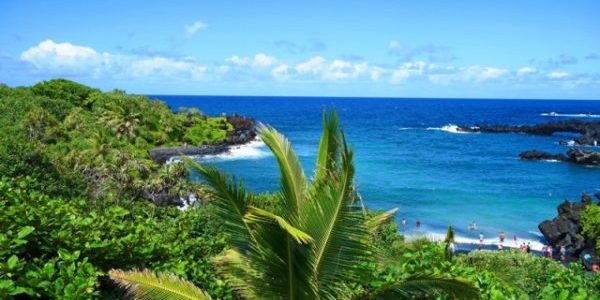The Road to Hana is a scenic drive that winds along the northeastern coast of Maui in Hawaii, stretching for about 64 miles from the town of Kahului to the small community of Hana. It is a popular tourist destination due to its stunning landscapes, unique flora and fauna, and numerous waterfalls and scenic vistas.
Along the way, visitors can see attractions such as the Wai’anapanapa State Park, which features a black sand beach, sea caves, and volcanic rock formations. The road also passes by the Ke’anae Peninsula, a small farming community with a picturesque ocean view.
However, the most famous attraction on the Road to Hana is the numerous waterfalls that dot the route. Among them are the Seven Sacred Pools of Ohe’o, a series of tiered waterfalls and pools that cascade down a steep ravine. Other notable waterfalls include the Wailua Falls, the Twin Falls, and the Makapipi Falls.
The allure of Hana Highway waterfalls as a must-see destination
The attraction of these waterfalls is their natural beauty and the opportunity to swim or hike in their vicinity. Visitors can cool off in the refreshing waters, dip in a natural pool, or enjoy a scenic picnic while admiring the views. These waterfalls are a must-see destination for anyone traveling to Maui and seeking a true tropical adventure.
The history and significance of the Road to Hana
The Road to Hana is more than just a scenic drive; it is a journey through history, culture, and nature. The road was originally built in the early 1900s to connect the town of Hana with other parts of Maui, allowing for the transportation of goods and people. Today, it is a popular tourist attraction, with visitors flocking to the road to experience its natural beauty and cultural significance.
The various waterfalls and their locations along the road
One of the most significant features of the Road to Hana is its waterfalls. The road passes by numerous big and small waterfalls, each with its unique charm. Some of the most notable waterfalls include:
- Wailua Falls: Located near mile marker 45, the Wailua Falls is a two-tiered waterfall that drops into a natural pool. It is one of the most easily accessible waterfalls, with a parking area and viewing platform just off the road.
- Twin Falls: Located near mile marker 2, the Twin Falls is a pair of waterfalls that drop into natural pools. It is a popular spot for swimming and picnicking, and there is a small fruit stand nearby where visitors can purchase fresh fruits and smoothies.
- Upper Waikani Falls (Three Bears Falls): Located near mile marker 19, the Upper Waikani Falls is a three-tiered waterfall that drops into three separate pools. It is known locally as the “Three Bears Falls” due to its resemblance to three bears stacked on top of each other.
- Seven Sacred Pools of Ohe’o: Located near mile marker 42, the Seven Sacred Pools of Ohe’o is a series of cascading waterfalls and pools that flow into the ocean. It is one of the most popular attractions on the road, with visitors coming to swim, hike, and picnic there.
When visiting the waterfalls along the Road to Hana, it is essential to stop at the designated viewing areas and follow any posted signs or warnings. Some waterfalls may have strong currents or other hazards, so it is necessary to exercise caution when swimming or exploring the area.
Tips for navigating the Road to Hana and visiting the waterfalls
Regarding navigating the Road to Hana, visitors should plan for a full day trip, as the road is winding and slow-going. It is also recommended to start early in the morning to avoid crowds and maximize time for exploring. Additionally, it is a good idea to bring plenty of water, snacks, sunscreen, and sturdy walking shoes for exploring the waterfalls and surrounding areas.
Overall, the Road to Hana and its waterfalls offer a unique and memorable experience for anyone seeking adventure, beauty, and a connection to nature and Hawaiian culture.
Options for touring the waterfalls, including guided tours and self-guided tours
When visiting the waterfalls along the Road to Hana, there are two main touring options: guided and self-guided. Each option has advantages and disadvantages, depending on individual preferences and needs.
Guided Tours:
Guided tours typically include transportation, a knowledgeable tour guide, and a pre-planned itinerary of stops at various waterfalls, scenic viewpoints, and cultural landmarks.
Advantages of guided tours include:
- Convenience: Guided tours take care of transportation and planning, saving time and effort for visitors who prefer a more structured experience.
- Knowledgeable Guides: Tour guides can provide insight into the history, culture, and natural features of the area, enhancing the visitor’s overall experience.
- Safety: Tour guides can help ensure the safety of visitors by providing guidance and advice on navigating the waterfalls and surrounding areas.
Disadvantages of guided tours may include:
- Cost: Guided tours can be more expensive than self-guided tours, especially for private or customized tours.
- Limited Flexibility: Guided tours may have a set itinerary, limiting visitors’ ability to explore the waterfalls and surrounding areas at their own pace.
Self-Guided Tours:
- Self-guided tours allow visitors to explore the Road to Hana and its waterfalls on their own without the assistance of a tour guide. Advantages of self-guided tours include:
- Flexibility: Self-guided tours allow visitors to explore the waterfalls and surrounding areas at their own pace, with the ability to stop and spend more time at their favorite spots.
- Cost: Self-guided tours are often less expensive than guided tours, as visitors can use their transportation and plan their itinerary.
Disadvantages of self-guided tours may include:
- Navigation: The Road to Hana can be challenging, especially for first-time visitors. Planning the route and stops and preparing for road conditions and hazards is essential.
- Safety: Visitors must take responsibility for their safety when exploring the waterfalls and surrounding areas, which can be challenging and potentially hazardous.
Visitors can research and compare various tour companies and options to plan and book a tour, considering their budget, preferences, and needs. It is also important to book in advance, especially during peak tourist season, to ensure availability and secure preferred dates and times.
Whether visitors choose a guided or self-guided tour, it is important to bring appropriate gear and supplies, including water, snacks, sunscreen, insect repellent, and sturdy walking shoes. It is also essential to respect the area’s natural environment and cultural significance by following any posted signs or guidelines and leaving no trace.








